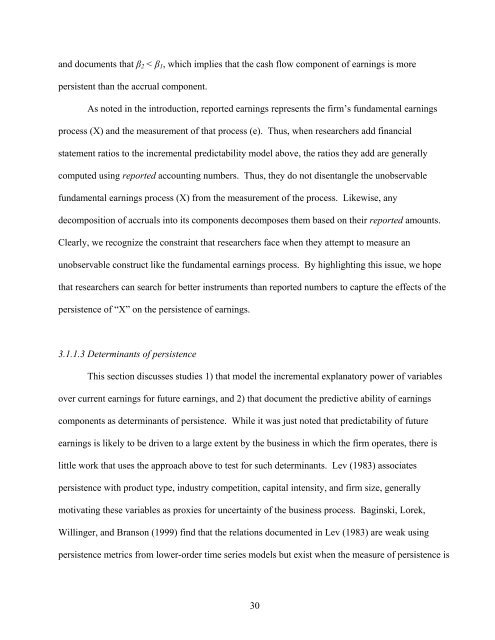Understanding earnings quality - MIT Sloan School of Management
Understanding earnings quality - MIT Sloan School of Management
Understanding earnings quality - MIT Sloan School of Management
Create successful ePaper yourself
Turn your PDF publications into a flip-book with our unique Google optimized e-Paper software.
and documents that β2 < β1, which implies that the cash flow component <strong>of</strong> <strong>earnings</strong> is more<br />
persistent than the accrual component.<br />
As noted in the introduction, reported <strong>earnings</strong> represents the firm’s fundamental <strong>earnings</strong><br />
process (X) and the measurement <strong>of</strong> that process (e). Thus, when researchers add financial<br />
statement ratios to the incremental predictability model above, the ratios they add are generally<br />
computed using reported accounting numbers. Thus, they do not disentangle the unobservable<br />
fundamental <strong>earnings</strong> process (X) from the measurement <strong>of</strong> the process. Likewise, any<br />
decomposition <strong>of</strong> accruals into its components decomposes them based on their reported amounts.<br />
Clearly, we recognize the constraint that researchers face when they attempt to measure an<br />
unobservable construct like the fundamental <strong>earnings</strong> process. By highlighting this issue, we hope<br />
that researchers can search for better instruments than reported numbers to capture the effects <strong>of</strong> the<br />
persistence <strong>of</strong> “X” on the persistence <strong>of</strong> <strong>earnings</strong>.<br />
3.1.1.3 Determinants <strong>of</strong> persistence<br />
This section discusses studies 1) that model the incremental explanatory power <strong>of</strong> variables<br />
over current <strong>earnings</strong> for future <strong>earnings</strong>, and 2) that document the predictive ability <strong>of</strong> <strong>earnings</strong><br />
components as determinants <strong>of</strong> persistence. While it was just noted that predictability <strong>of</strong> future<br />
<strong>earnings</strong> is likely to be driven to a large extent by the business in which the firm operates, there is<br />
little work that uses the approach above to test for such determinants. Lev (1983) associates<br />
persistence with product type, industry competition, capital intensity, and firm size, generally<br />
motivating these variables as proxies for uncertainty <strong>of</strong> the business process. Baginski, Lorek,<br />
Willinger, and Branson (1999) find that the relations documented in Lev (1983) are weak using<br />
persistence metrics from lower-order time series models but exist when the measure <strong>of</strong> persistence is<br />
30
















